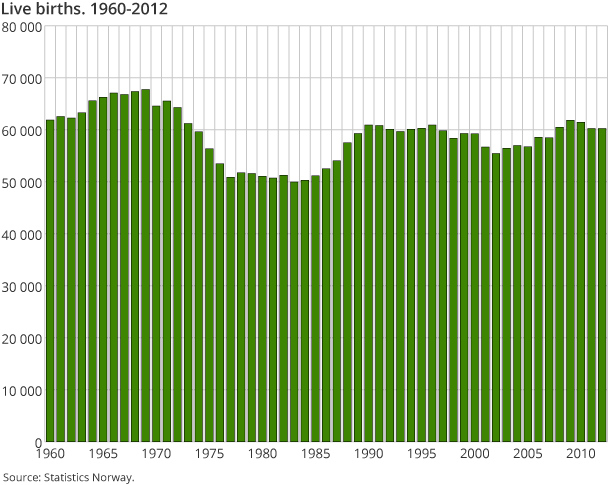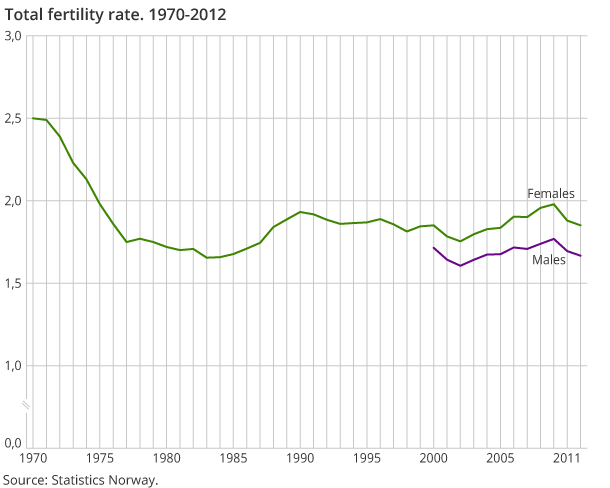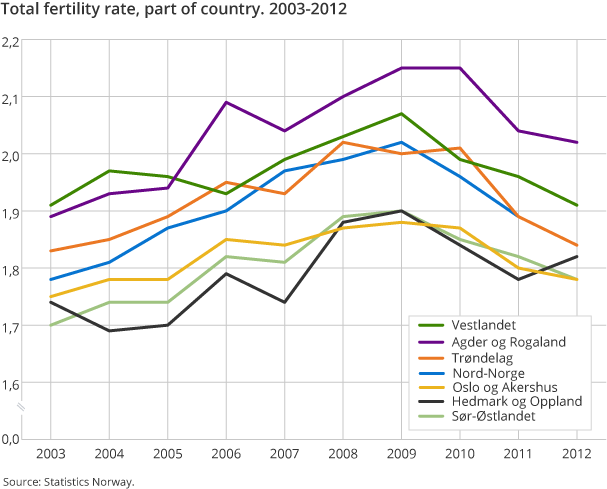Content
Published:
This is an archived release.
Stability in births
A total of 60 300 children were born in Norway during 2012, almost as many as the previous year. The corresponding fertility rate was 1.85. This is the third year where the total fertility rate has decreased, after peaking in 2009 at 1.98.
| 2012 | Change in per cent | ||
|---|---|---|---|
| 2011 - 2012 | 2002 - 2012 | ||
| Live births | |||
| Total | 60 255 | 0.1 | 8.7 |
| Boys | 30 933 | -0.2 | 9.2 |
| Girls | 29 322 | 0.4 | 8.2 |
| Total fertility rate | |||
| Women | 1.85 | -1.6 | 5.7 |
| Men | 1.68 | -1.2 | 4.3 |
| Age at first birth | |||
| Mother | 28.5 | 0.4 | 2.5 |
| Father | 31.2 | 0.3 | 2.3 |
| Cohabitation status of mother | |||
| Married | 26 224 | -1.0 | -4.0 |
| Cohabitation | 26 022 | 1.6 | 21.8 |
| Single | 8 009 | -1.5 | 18.6 |
At the start of the 1970s, the total fertility rate was 2.73. The fertility rate then continued to fall until the mid 1980s when it bottomed at 1.66. An increase followed, which continued until the start of the 1990s, followed by a fall up to 2002. From then, it increased and peaked in 2009 at 1.98. The last three years have seen a decrease.
In 2011, Iceland had a total fertility rate of 2.02, followed by Sweden with 1.90, Finland 1.83 and Denmark 1.76.
Highest fertility in Agder and Rogaland
With regard to the fertility by region in the last 10 years, women from Agder and Rogaland had the highest fertility in Norway, followed by women from Western Norway. Women from Trøndelag and Northern Norway had the same level of fertility in the period. The lowest fertility rate was among women from Hedmark and Oppland, but in the past year this has been the only part of the country where the fertility rate has increased. Thus, women from Oslo/ Akershus and women the rest of Eastern Norway had the lowest fertility rate in 2012.
Small change in the mother’s and father’s age at birth
The mean age at first child’s birth was 28.5 years for women and 31.2 for men in 2012. This is an increase of 0.1 years for both women and men compared with the year before. Women aged 30-34 had the highest fertility rate in 2012, and this is the third year that women in this age group have given birth to most children. Previously, it was women aged 25-29 who bore most children. Compared with 2011, the fertility rates decreased or were unchanged for all age groups, except for women aged 35-39 years, where the rate increased by 0.5.
Among the counties, 55 per cent of the children born in Vest-Agder had married parents, 54 per cent of the children born in Nord-Trøndelag had cohabitating parents and 25 per cent of the children born in Finnmark had a single mother.
In 2012, 1 000 sets of twins were born and 18 sets of triplets, corresponding to 17.1 multiple births per 1 000 births. Last year there were 184 still births. With the exception of 2005, this is the lowest number ever registered.
Contact
-
Statistics Norway's Information Centre
E-mail: informasjon@ssb.no
tel.: (+47) 21 09 46 42
-
Espen Andersen
E-mail: espen.andersen@ssb.no
tel.: (+47) 92 61 00 46
-
Ane Margrete Tømmerås
E-mail: ane.tommeras@ssb.no
tel.: (+47) 91 99 29 62
-
Oppdrag befolkningsstatistikk
E-mail: befolkning@ssb.no



